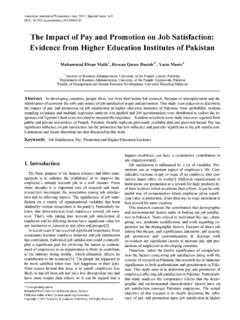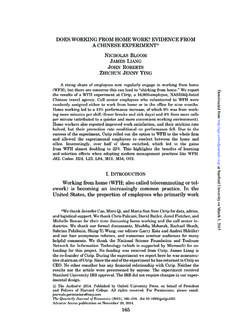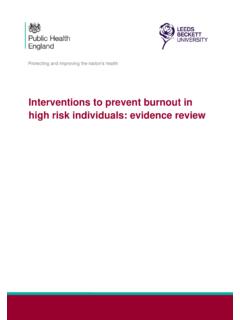Transcription of Organizational and environmental factors that affect ...
1 Organizational and environmental factors that affect worker health and safety and patient outcomes Tammy Lundstrom, MDa Gina Pugliese, RN, MSb Judene Bartley, MS, MPH, CICb Jack Cox, MD,b Carol Guither, BA, MSb,c Detroit, Michigan, and Oakbrook, Illinois This article reviews Organizational factors that influence the satisfaction , health, safety, and well-being of health care work- ers and ultimately, the satisfaction , safety, and quality of care for patients. The impact of the work environment on working conditions and the effects on health care workers and patients are also addressed. Studies focusing on worker health and safety concerns affected by the organization and the physical work environment provide evidence of direct positive and/or adverse effects on performance and suggest indirect effects on the quality of patient care. The strongest links between work- er and patient outcomes are demonstrated in literature on nosocomial transmission of infections. Transmission of infections from worker to patient and from patient to patient via health care worker has been well documented in clinical studies.
2 Literature on outbreaks of infectious diseases in health care settings has linked the physical environment with adverse patient and worker outcomes. An increasing number of studies are looking at the relationship between improvement in orga- nizational factors and measurable and positive change in patient outcomes. Characteristics of selected magnet hospitals are reviewed as one model for improving patient and worker outcomes. (Am J Infect Control 2002;30:93-106.). This article reviews Organizational factors that have Much attention has been focused on patient safety been shown to influence the satisfaction , health, in recent years. It has been noted that healthy work safety, and well-being of health care workers and organizations demonstrate both financial success ultimately, the satisfaction , safety, and quality of and a healthy workforce1 a fact recognized by care for patients. The impact of the work environ- many purchasers of health care services. Purchasers ment on working conditions and the effects on are beginning to use this type of data to make con- health care workers and patients are also addressed.
3 Tracting decisions. For example, The LeapFrog Group, a consortium of Fortune 500 companies and Although this review of these issues cannot be all- large purchasers of health care services (eg, General inclusive, it provides information that may be used Electric, General Motors), requires providers to to enhance patient safety programs, including strate- implement evidence-based quality and safety prac- gies that have been shown to affect quality as well as tices, including use of computerized physician order the bottom line. This understanding of the complex- entry, referrals to hospitals that handle a specified ity and magnitude of changes required to positively volume of certain procedures, and management of affect workers, their environment, and patient out- intensive care units (ICUs) by physicians certified (or comes will help set future research priorities in areas eligible) in critical care medicine. where there are gaps in knowledge. WORKER HEALTH AND SAFETY: From the Detroit Medical Center,Wayne State University, Detroit, Micha; EFFECT OF THE ORGANIZATION.
4 Safety Institute, Premier Inc, Oak Brook, Illb; and General Motors, MIKA AND THE WORK ENVIRONMENT. Systems, Background Reprint requests: Gina Pugliese, RN, MS, Safety Institute, Premier Inc, 700. Commerce Dr, Suite 100, Oakbrook IL 60523. A wealth of literature exists on how health care work- Copyright 2002 by the Association for Professionals in Infection ers experience job- and work-environment related Control and Epidemiology, Inc. stressors that adversely affect their safety and 0196-6553/2002/$ + 0 17/46/119820 health. Studies have identified many stressors, including role ambiguity, role conflict, heavy work- 93. 94 Vol. 30 No. 2 Lundstrom et al load, pressure, and physical Work Experts have suggested that burnout results from a stress has been shown to result in job dissatisfaction, variety of stresses, including situations in which work burnout (physical, emotional, and mental exhaus- demands cannot be met because of a lack of tion), staff turnover, occupational illness and injuries, resources such as social support from coworkers and reduced mental health, depression, and even sui- supervisors, job control, participation in decision- making, utilization of skills, and reinforcements such as Stress and job burnout also are related to However, studies have also shown that the negative specific demands of work, including overload, varia- impact of these stressors can be reduced by factors tions in workload, role conflict, and role such as a supportive social environment that 4,21-25 Workers who perceive a high level of stress and includes coworkers and supervisors, peer and team resulting job burnout have poor coping responses and cohesion, autonomy, utilization of skills, rewards, lack of job satisfaction .
5 Which often erode commit- and an emphasis on planning and ment to the organization and lead to higher Working in an organization with a strong and visible commitment to safety also has a positive impact on Lack of coworker and supervisor support contributes the health and safety of ,9,10 Although to perceived stress and resulting ,27 In one empirical evidence is lacking, studies suggest work- study of performance among nurses by Salyer,25 a er attitudes, job satisfaction , and employee health higher number of admissions to/discharges from a and well-being are related to work performance; pro- patient care unit in 24 hours had a negative impact ductivity; and ultimately, the quality of health care on the self-rated quality of performance. Workload services. (number of emergency admissions), number of deaths on the ward, and number of menial tasks Safety climate performed contributed to medical residents' percep- The safety climate is defined as shared perceptions tion of being overwhelmed and increased the num- of workers regarding the level of safety of their work ber of reported minor medical Lack of Table 1 lists 6 Organizational dimen- peer support, role ambiguity, and perceived stress sions that have been identified as part of the hospi- were associated with job dissatisfaction and depres- tal safety climate.
6 Sion among Most important of these dimensions are manage- In a meta-analysis of 61 studies of job burnout, indi- ment commitment and safety performance feedback viduals were more sensitive (ie, at greater risk of from managers and ,12-14 A strong safe- emotional exhaustion) to demands of the job than to ty climate is associated with positive attitudes among available resources. Lee and Ashforth2 hypothesized workers, which can influence the adoption of safe that this sensitivity might be related to the ability to behaviors and practices15-17 and help reduce acci- increase resources and thus compensate for the dents and ,18,19 Positive attitudes also influ- work demands, whereas the emotional demands of ence job satisfaction and Incorporating the job remained constant. elements needed for a positive safety climate is the first step in influencing worker and patient safety. Several studies have shown that job stress may be a Workers need to know that administration is con- risk factor for hypertension and increases in left ven- cerned about their safety; supports their efforts; and tricular mass index.
7 In physicians, job stress increas- will use information on safety-related issues, prob- es diastolic blood This increase may be lems, and errors only to improve the system and not related to inexperience because senior staff mem- for retribution. bers had lower blood pressure elevations than their junior colleagues. Finally, shift work is a risk factor for Stress and job burnout myocardial infarction unrelated to smoking, job Job burnout is believed to result from stress in ser- strain, or job education vice occupations such as those in the health care industry and is believed to represent a unique Work-related illnesses and injuries response to frequent and intense client/patient inter- A number of studies have linked job stressors to Workers with burnout report a variety of increased risk of work-related injuries and illness. symptoms, including emotional exhaustion, deper- sonalization (feeling distant from others), and a Coronary artery disease. Several studies, includ- sense of diminished personal accomplishment.
8 Ing the Framington Heart Study, have linked job Lundstrom et al April 2002 95. design factors and the organization of work to leadership (support of nursing initiatives and deci- increased risk of cardiovascular Among sion-making) and resource adequacy (sufficient staff these factors were minimal opportunities to learn to provide quality care and enough time to discuss new things, hectic or monotonous work, and low lev- patient care problems with other nurses). Nurses els of job control and social support. working on hospital units with poorer work climates and lower staffing were found to be twice as likely to Johnson-Pawlson and Infeld37 used multivariate incur needlestick injuries or near-misses and to logistic regression analysis (controlling for personal report factors that placed them at risk for injury. and other work organization variables) to show that workers with low levels of job control had an Other infectious disease exposures. Many increased relative risk of cardiovascular disease investigations have addressed the risks of occupa- mortality ( ) compared with workers with higher tionally acquired infections among health care work- levels of control.
9 Individuals with combined low job ers from exposures to numerous sources, including control and poor social support from coworkers had patients, visitors, other health care workers, and the an even higher relative risk ( ) of cardiovascular environment. Also, numerous opportunities exist for disease mortality compared with workers with high health care workers to increase the risk of infection job control and social support. Conversely, high lev- in patients. For example, a health care worker with a els of job control were found to be protective against transmissible infection may transmit it to a patient cardiovascular disease mortality. during a patient care interaction. Reducing these risks requires identification and management of Musculoskeletal disorders. A National Institute infected workers as well as appropriate vaccination of Occupational Safety and Health report38 found a of Positive patient outcomes related to number of work-related factors to be associated worker health have been reported.
10 For example, with upper-extremity musculoskeletal disorders. influenza vaccination of health care workers has These included work pressure, high work demands, reduced influenza-related mortality in the elderly in surges in work loads, lack of job diversity, little deci- long-term care facilities and ,45. sion-making opportunity, fear of being replaced by computers, and lack of coworker support. Other The Centers for Disease Control and Prevention studies have confirmed that the combination of high (CDC) has published extensive guidelines that review work pressure, low task control, fear of job loss, or the evidence for transmission of infection to and lack of promotion contributes to increased reports from patients and recommend practices for preven- of stress and related musculoskeletal tion and control of Bloodborne pathogen exposures. The work Organizational factors that impact worker environment and hospital safety climate influence performance compliance with Universal Precautions and other Delivery systems.













